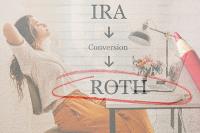(Roth) Conversion Therapy

The increase of required minimum distribution (RMD) age from 72 to 73 this year, and to 75 in ten years, has the potential of creating some pretty impressive tax implications for those with larger retirement plan balances. While it is all well and good to put off taking distributions until you absolutely have to, you should be aware of how that decision impacts not only your own tax situation, but also the tax situation of your beneficiaries. Because, remember that non-spouse beneficiaries of retirement accounts now have to distribute retirement account balances within a ten-year period after the death of the account owner.
For some clients, we recommend taking regular distributions from IRAs or retirement accounts, even before required to do so for tax smoothing. In other words, you keep your income within a desired tax range rather than bouncing from a high bracket to a much lower one and then back up again. This is a great strategy to implement if you want to build up taxable investments, which provide cash flow flexibility and are better for beneficiaries to inherit. If you really don’t require the distribution for cash flow purposes, you can achieve the same thing by doing Roth conversions. Both strategies are effective if you believe that we are at historically low tax rates and are at all concerned about the sunset of current tax laws in 2025.
Let’s consider why you might choose a Roth conversion over simply taking earlier distributions. The first, and biggest, reason is that once you pay taxes on the conversion, then theoretically no one has to ever pay taxes on that money again. Keep in mind that if the Roth account is less than five years old at the time of withdrawal, then earnings from an inherited Roth IRA will be taxable.
Second, the account holder does not have to distribute from a Roth IRA, which allows those balances to grow a lot more if the idea is to leave these assets to heirs. Beneficiaries still have to contend with getting the dollars out in a ten-year period. But not having to pay taxes on the distributions makes that rule less onerous. Starting in 2024, participants with Roth 401(k) balances will also not have to take distributions from these accounts. Previously, retirement plan participants would have to rollover their Roth balances to a Roth IRA to avoid having to take distributions. This is a major shift which puts qualified retirement plans in line with IRAs in terms of RMD rules.
The next question to consider may be how much to convert (or distribute). For this, you will want to know your current tax bracket and how much additional income you can afford to report before you move into the next tax bracket. This is called filling your tax bracket. Ideally, you will aim to convert enough to maximize the tax bracket that you are currently in. If you have basis in the IRA you are converting, be sure to factor that into the calculation. Also, note that all of your IRA assets will be included in the tax calculation associated with a Roth conversion. However, qualified plan balances are not included. So, plan on doing any anticipated Roth conversions before you roll over any 401(k) plan balances.
Clearly there are a lot of moving parts to consider in a Roth conversion, not the least of which is whether it makes any sense for you, given your own, unique circumstances. We are here for those types of discussions and are prepared to do the analysis.
Meet Kristan Anderson, CEBS®, CFP® »
Read the February 2023 Financial Focus:
- "The Big (Lifestyle) Creep" by Kristan Anderson, CEBS®, CFP® »
- "Financial Planning 101 – Account Consolidation" by Kristan Anderson, CEBS®, CFP® »
- "Charitable Gifting with IRAs" by Victoria Henry, CFP® »
Disclosure
West Financial Services, Inc. (“WFS”) offers investment advisory services and is registered with the U.S. Securities and Exchange Commission (“SEC”). SEC registration does not constitute an endorsement of the firm by the SEC nor does it indicate that the firm has attained a particular level of skill or ability. You should carefully read and review all information provided by WFS, including Form ADV Part 1A, Part 2A brochure and all supplements, and Form CRS.
This information is intended to be educational in nature, and not as a recommendation of any particular strategy, approach, product or concept. These materials are not intended as any form of substitute for individualized investment advice. The discussion is general in nature, and therefore not intended to recommend or endorse any asset class, security, or technical aspect of any security for the purpose of allowing a reader to use the approach on their own. You should not treat these materials as advice in relation to legal, taxation, or investment matters. Before participating in any investment program or making any investment, clients as well as all other readers are encouraged to consult with their own professional advisers, including investment advisers and tax advisers.
Certain information contained herein was derived from third party sources as indicated. While the information presented herein is believed to be reliable, no representation or warranty is made concerning the accuracy of any information presented. We have not and will not independently verify this information. Where such sources include opinions and projections, such opinions and projections should be ascribed only to the applicable third party source and not to WFS.

